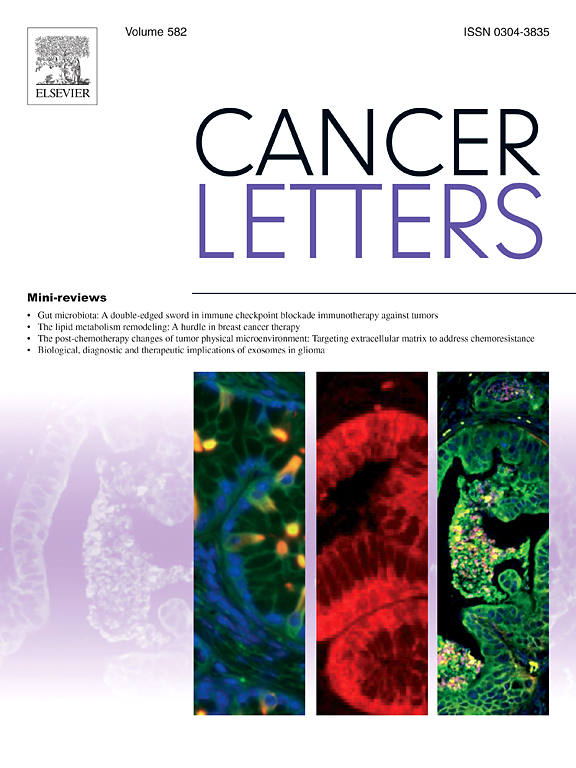雷公藤甲素及其衍生碳化纳米材料的抗sars - cov -2和抗癌特性
IF 9.1
1区 医学
Q1 ONCOLOGY
引用次数: 0
摘要
COVID-19大流行仍然是一个持续的全球健康威胁,但仍然缺乏有效的治疗方法。这导致了对补充/替代药物的高需求,例如用于遏制COVID-19大流行的中草药。鉴于许多草药具有抗癌和抗病毒的双重活性,它们可能在治疗癌症和SARS-CoV-2方面具有多方面的潜力。雷公藤甲素是从雷公藤中分离出来的主要生物活性化合物,雷公藤甲素是一种传统的中草药,被认为对许多疾病,包括癌症和病毒感染都有有益的药理作用。然而,由于其毒性和水溶性差,在临床上的应用受到了很大的限制。在这里,我们从中国药典的天然化合物文库中筛选出雷公藤甲素作为抑制SARS-CoV-2细胞进入的首选候选药物。我们证明雷公藤甲素在细胞模型中以纳摩尔浓度强有力地阻断病毒进入,对新出现的SARS-CoV-2的Omicron变体具有广泛的活性。从机制上讲,雷公藤甲素破坏了SARS-CoV-2刺突蛋白与其受体ACE2的相互作用。此外,我们合成了水溶性的雷公藤甲素衍生的碳量子点。与雷公藤甲素相比,这些高度生物相容性的纳米材料对SARS-CoV-2的Omicron变体表现出突出的抗病毒能力,且细胞毒性较低。最后,我们发现雷公藤甲素衍生的碳化材料在抗癌性能上优于雷公藤甲素和Minnelide(雷公藤甲素的水溶性类似物)。总之,我们的研究结果为雷公藤甲素碳化衍生物的潜在开发提供了理论依据,作为当前大流行和未来爆发的有希望的抗病毒候选药物,以及抗癌药物。本文章由计算机程序翻译,如有差异,请以英文原文为准。
Anti-SARS-CoV-2 and anticancer properties of triptolide and its derived carbonized nanomaterials
The COVID-19 pandemic remains an ongoing global health threat, yet effective treatments are still lacking. This has led to a high demand for complementary/alternative medicine, such as Chinese herbal medicines for curbing the COVID-19 pandemic. Given the dual anticancer and antiviral activities of many herbal drugs, they may hold a multifaceted potential to tackle both cancer and SARS-CoV-2. Triptolide is the major bioactive compound isolated from Tripterygium wilfordii Hook F (TwHF), a traditional Chinese medicinal herb recognized for its beneficial pharmacological properties in many diseases, including cancer and viral infection. However, its application in the clinic has been greatly limited due to its toxicity and poor water solubility. Here, from a screen of a natural compound library of Chinese Pharmacopoeia, we identified triptolide as a top candidate to inhibit cell entry of SARS-CoV-2. We demonstrated that triptolide robustly blocked viral entry at nanomolar concentrations in cellular models, with broad range activity against emerging Omicron variants of SARS-CoV-2. Mechanistically, triptolide disrupted the interaction of SARS-CoV-2 spike protein with its receptor ACE2. Furthermore, we synthesized water-soluble, triptolide-derived carbon quantum dots. Compared to triptolide, these highly biocompatible nanomaterials exhibited prominent antiviral capabilities against Omicron variants of SARS-CoV-2 with less cytotoxicity. Finally, we showed that triptolide-derived carbonized materials excelled in their anticancer properties compared to triptolide and Minnelide, a water-soluble analog of triptolide. Together, our results provide a rationale for the potential development of triptolide-carbonized derivatives as a promising antiviral candidate for the current pandemic and future outbreaks, as well as anticancer agents.
求助全文
通过发布文献求助,成功后即可免费获取论文全文。
去求助
来源期刊

Cancer letters
医学-肿瘤学
CiteScore
17.70
自引率
2.10%
发文量
427
审稿时长
15 days
期刊介绍:
Cancer Letters is a reputable international journal that serves as a platform for significant and original contributions in cancer research. The journal welcomes both full-length articles and Mini Reviews in the wide-ranging field of basic and translational oncology. Furthermore, it frequently presents Special Issues that shed light on current and topical areas in cancer research.
Cancer Letters is highly interested in various fundamental aspects that can cater to a diverse readership. These areas include the molecular genetics and cell biology of cancer, radiation biology, molecular pathology, hormones and cancer, viral oncology, metastasis, and chemoprevention. The journal actively focuses on experimental therapeutics, particularly the advancement of targeted therapies for personalized cancer medicine, such as metronomic chemotherapy.
By publishing groundbreaking research and promoting advancements in cancer treatments, Cancer Letters aims to actively contribute to the fight against cancer and the improvement of patient outcomes.
 求助内容:
求助内容: 应助结果提醒方式:
应助结果提醒方式:


